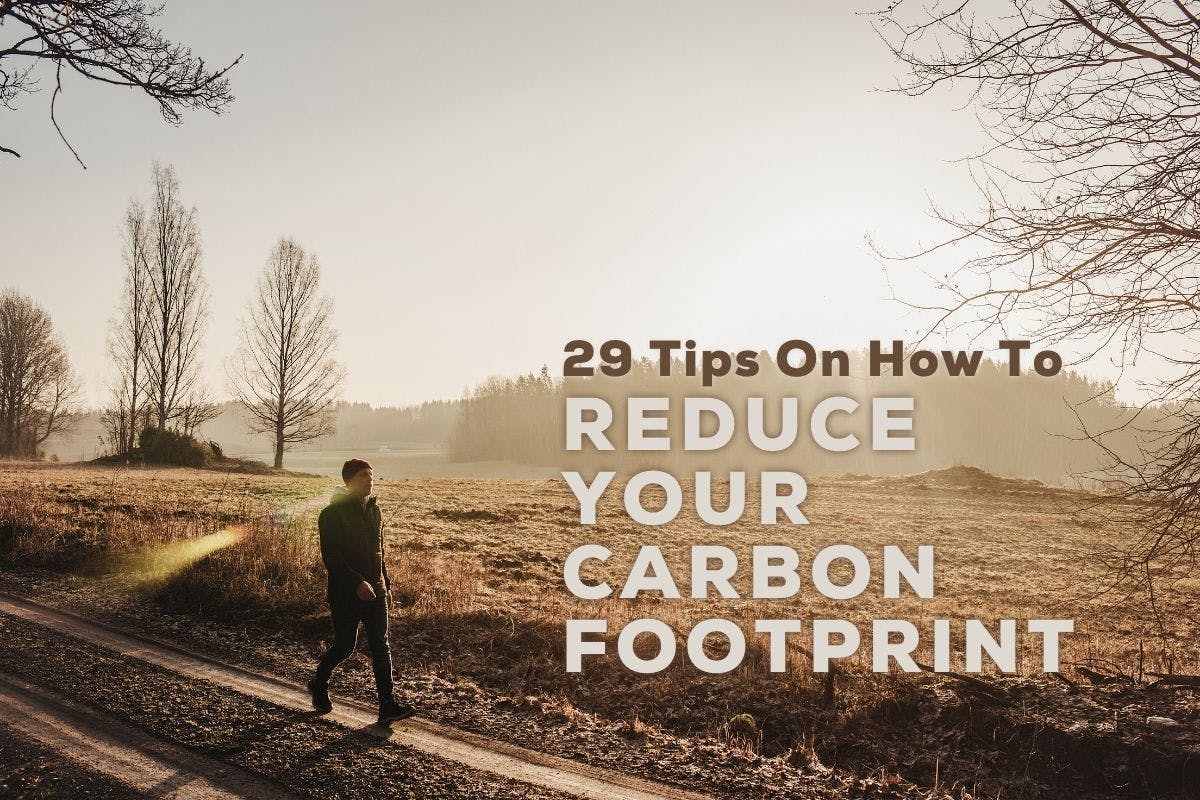29 Green Tips on How To Reduce Your Carbon Footprint
Last edited

Author
Cory O'Brien
Senior Director - Growth Marketing

Editor
Ryan Barnett
SVP, Policy & New Market Development

Most people want to help the environment, but they aren't sure where to start. The problem can seem too big for the actions of one person to solve. At Palmetto, we believe that everyone can work together by reducing greenhouse gas emissions and helping lower our global carbon footprint. By following a few small tips on how to reduce your carbon footprint, you can create big changes that help the planet.
See how much you can save with home energy changes
What Is Your Carbon Footprint?
Your carbon footprint is a measure of the greenhouse gases, such as carbon dioxide and methane, that you generate through everyday activities including driving, flying, electricity usage, and even the food you eat. By calculating your carbon footprint, you can see how your actions contribute to global carbon emissions, make better decisions, and change your actions based on the results.
For more information and Palmetto’s carbon footprint definition, check out What is a Carbon Footprint?
Why You Should Want To Reduce Your Carbon Footprint
A high carbon footprint negatively affects the Earth and contributes directly to climate change. On a global scale, greenhouse gas emissions trap heat and impact weather patterns - creating warmer days that last farther into the year, unpredictable snowstorms, and an increase in devastating hurricanes.
To decrease our global carbon footprint, individuals must understand their own footprint, and learn how they can work together with others to improve the environment. The benefits of reducing our carbon footprint include the following:
- Reversing Global Warming - The global temperature is rising rapidly. A decrease in our global carbon footprint could dramatically slow the rate of increase.
- Improved Global Health - Lowering our carbon footprint means lower levels of carbon dioxide, methane, and other pollutants in the air we breathe and the water we drink.
- Saving Money - Extreme weather can increase the costs to our healthcare and emergency systems. Reducing the frequency and intensity of events can positively impact both governmental and personal budgets.
- Protects Animal and Plant Life - Lowering the global temperature will aid biodiversity and slow down the harmful changes happening to the habitats of animals and plants around the world.
29 Ways To Reduce Your Carbon Footprint
Lowering your carbon footprint may sound impossible, but taking any of these 29 simple steps can make a difference for the environment. Every action taken by every human on this planet adds up! Together, we can make a huge impact and help to heal the environment.
Tip #1: Avoid Plastic Water Bottles
It is easy to grab a disposable plastic water bottle when you’re on the go, but that plastic will eventually end up in a landfill or, even worse, in our oceans. Instead, find a reusable water bottle that you can carry with you throughout the day, and fill it up each time you need water.
Tip #2: Recycle
You use more recyclable materials on a daily basis than you might think. Learn the recycling guidelines for your area so you know what to send to the recycling center, and prevent unnecessary waste from reaching our landfills.
Tip #3: Keep Unwanted Items Out of Landfills
Instead of throwing away items you no longer want, be more climate-friendly by trying to sell them, recycle them, donate them, or repurpose them for something else.
Tip #4: Buy Sustainable Products
When you are shopping, look for a logo that says your item was made under sustainable conditions. Buying second-hand or vintage items rather than buying brand new products can also help prevent materials from reaching the landfill prematurely, and reduce the carbon costs associated with manufacturing.
Tip #5: Buy Fewer Clothes
It is easy to get caught up in the newest fashion trends, but too many clothes end up in landfills after just a few wears or as soon as the trend passes. These products then decompose and produce methane, a greenhouse gas that is bad for the environment.
Tip #6: Adjust Your Shopping Habits
While buying shiny new things is appealing, try to limit how much you buy overall. If possible, buy used or recycled products, and seek out items that don't use excess packaging to help decrease your carbon footprint.
Tip #7: Eat Less Red Meat
The livestock industry adds high levels of greenhouse gases into our atmosphere each year. By eating less red meat and more plant-based foods like fruits, veggies, beans, and grains, you can help with reducing carbon emissions and lowering your carbon footprint.
Tip #8: Don't Buy Too Much Food
In the US, people tend to overbuy food and end up throwing a lot of it away. Here are three ways to avoid buying too much the next time you go shopping:
- Take stock of what you already have before you go to the grocery store.
- Don't buy in bulk unless you are sure you will use it before it goes bad.
- Plan your meals ahead of time so you know exactly what and how much you need.
Tip #9: Create a Compost Pile
If you do end up with food you don't use, you can create a compost pile. Even organic waste can create harmful gases when sitting in a landfill. Composting allows this waste to decompose naturally, and the resulting compost can be used to improve the soil in the rest of your yard.
See how much you can save with home energy changes
Tip #10: Buy and Eat Local
When you buy food from all over the globe, the transportation required to move those items from the producer to your kitchen results in high levels of greenhouse gasses. If you buy locally, not only are you supporting a local business, but you help to reduce the carbon footprint associated with transporting food.
Tip #11: Cut Down Fewer Trees
Try to avoid supporting businesses that cut down excessive amounts of trees to run their operation. Deforestation, or the rapid cutting down of trees, is a leading cause of climate change on two fronts:
- Trees absorb carbon dioxide from our atmosphere, so fewer trees result in less carbon absorption.
- Trees also store carbon, which is released into the atmosphere when they are processed or burned.
Tip #12: Replace Cell Phones Less Often
Each year, people clamor to buy the newest phone with the newest features, even if they just got a new phone the year before. Unfortunately, producing these phones creates a huge carbon footprint, so buying them less frequently will help offset those emissions.
Tip #13: Raise Awareness
As you learn more and make changes to reduce your own carbon footprint, you can help others to do the same! Talk to people about how our actions impact the planet. Share information that resonates with you, and offer ideas on how to reduce our individual and global carbon footprint.
Tip #14: Drive Less
The more you drive, the more greenhouse gases you produce. Consider carpooling, taking the train or bus, walking, or riding your bike whenever possible to lower your emissions. If you must drive, consider one of the newer electric cars that produce zero emissions while operating.
Tip #15: Take Care of Your Car
If your car is in poor shape, it might have to work harder than it should, which means it could produce more greenhouse gasses than it would when properly tuned. For example, low tire pressure increases engine activity, which increases emissions that contribute to your carbon footprint.
Tip #16: Adjust Your Driving Speed
When driving a motor vehicle, try to avoid dramatically accelerating and slowing down. It requires less fuel if you maintain a consistent speed as often as possible. You can also use apps like Waze to avoid traffic jams so you don’t idle for long periods of time.
Tip #17: Work Remotely
For many industries, it’s now easier than ever to work remotely. Apps like Zoom or Slack make it possible to connect with your team without driving to work, which can reduce your carbon footprint. You can also save energy and waste by printing less and relying on digital documents instead.
(Looking for a remote position? Join our team! Palmetto is proud to be a remote company, and you can find a list of currently open positions at Palmetto Careers.)
Tip #18: Use Public Transport
While most buses and trains do produce carbon emissions, the emissions are spread out over a large group of people. In contrast, when you drive your car, your emissions belong only to you and your passengers.
Tip #19: Fly Less
Flying leaves a huge carbon footprint, so if you can take even one less flight a year, it will reduce your emissions substantially. If you can't avoid flying, consider buying carbon offsets or donating money to an organization that promotes sustainability.
Tip #20: Wash Your Clothes Properly
You’ll use fewer resources if you wash your clothes with cold water and in full loads. You can also line dry your clothes rather than using a dryer to further reduce your carbon footprint.
Tip #21: Conserve Water
Set your water heater to 120°F, install a low-flow showerhead, and shorten your shower time. Combined, those steps will waste less water and save energy, which can lead to lower utility bills.
Tip #22: Complete an Energy Audit
An energy audit will help you determine where you’re wasting energy, and what you can do to improve your energy usage and be more environmentally friendly. You can do your own energy audit at home or call in a professional.
Tip #23: Use Less Everyday Electricity
Whenever you aren't in a room, turn off the lights. When you aren't using your electronics, including device chargers, unplug them. You will save money on electricity costs while also lowering your carbon footprint.
Tip #24: Make Your Home Energy Efficient
Increase your home's energy efficiency by checking the seals on your doors, using energy-efficient light bulbs, and installing double-pane windows.
Tip #25: Insulate Your Home
You may be surprised to find out how much energy you can waste if your home isn’t properly insulated. If you have areas of your home that aren't sealed well, heat and air conditioning can escape, which makes it much harder for you to keep your home at the temperature you desire. This causes your HVAC unit to run more than it should, which creates a larger carbon footprint.
Tip #26: Improve Your Thermostat Usage
It can be tempting to blast the heat or air conditioning on a particularly chilly or hot day, but try to avoid this when possible. Consider setting your thermostat to 78°F for warm days and 68°F for colder days, and check out our Recommended Thermostat Settings For Each Season.
Tip #27: Install Energy-Efficient Appliances
When replacing older appliances, especially larger ones like refrigerators, microwaves, and ovens, buy energy-efficient models marked with the Energy Star sticker. You can often recoup the higher costs in just a few years thanks to lower electricity bills.
Tip #28: Choose Better Streaming
Many households use streaming services these days, but some streaming methods have higher energy consumption than others. Smart TVs are optimized to stream movies and television shows, whereas game consoles use up to ten times more energy when they’re powered on.
Tip #29: Support Clean Energy
Clean energy sources like solar and wind power have a much smaller carbon footprint than traditional energy sources like coal, oil, and gas. If you own your home, you can install solar panels on your roof and reduce your reliance on fossil fuels.
How To Reduce Your Carbon Footprint
Every human on Earth has a personal carbon footprint that contributes to the global carbon footprint. The only way we will be able to tackle our environmental crisis is to work together. If everyone takes steps to reduce their carbon footprint, we can prevent climate change and make a better future for everyone and everything.
While making changes that will lower your carbon footprint may seem difficult, it is actually easier than you think. By following the tips on this list, you will be well on your way to making a difference.
Learn how you can lower your carbon footprint and save money by installing a solar panel system in your home with our Solar Design Tool. Using solar energy can help you lower your carbon footprint because you aren’t using electricity created from fossil fuels. Start your journey to improving your carbon footprint today!


